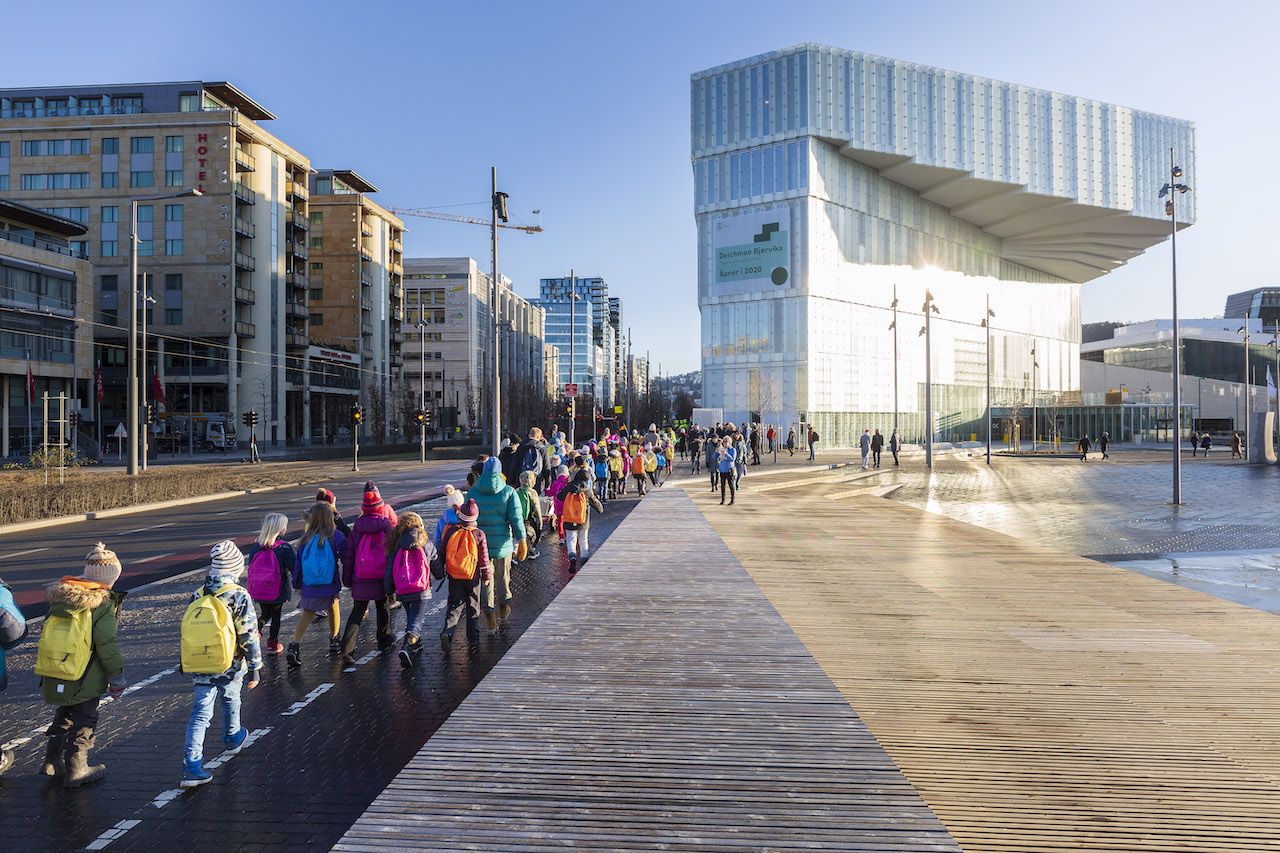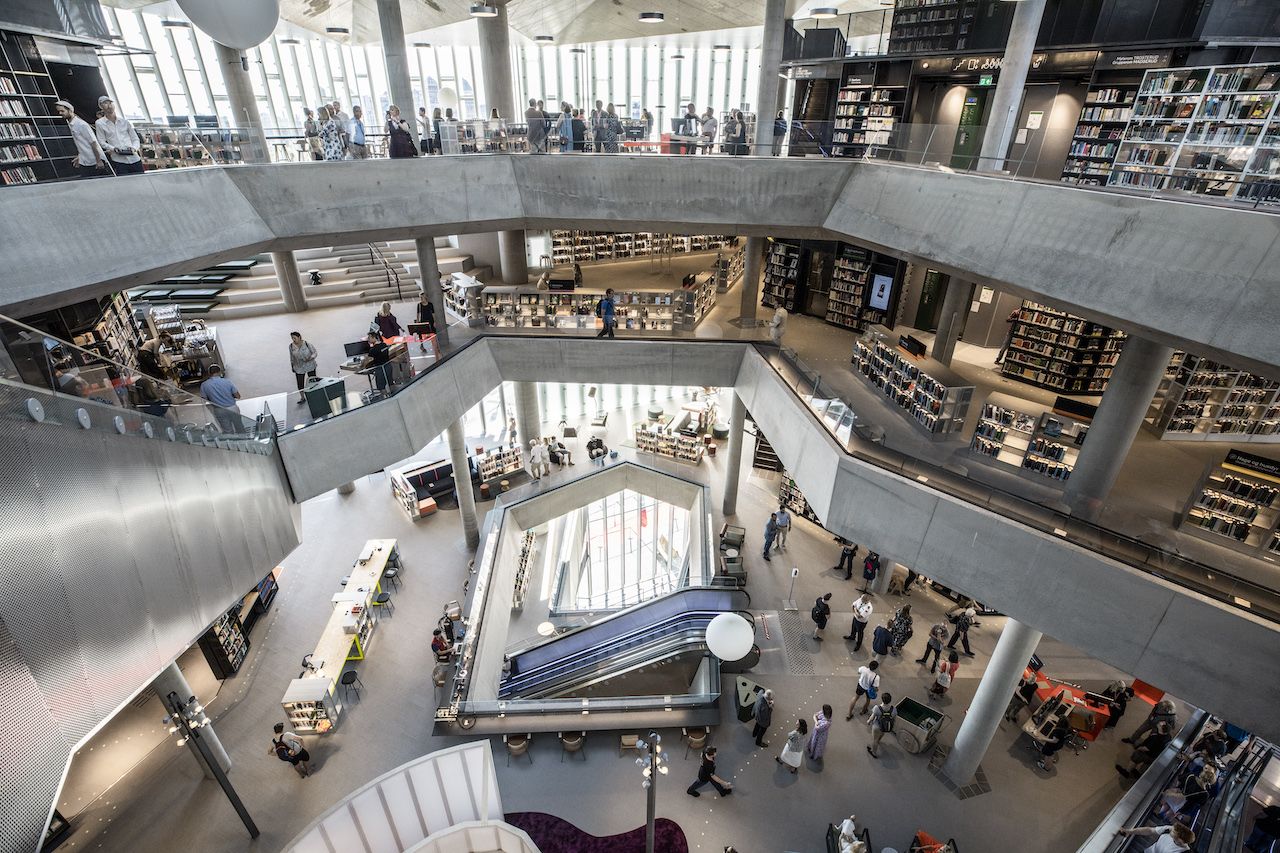
Exterior of Deichman Bjørvik, the best library in the world in 2021 (Croissant, 2021)
“A library is not a mean[s] in itself – it is [a] way to empower people, make communities stronger, and a solution to some of the problems and challenges that societies face” (Lauersen, 2021). One of the most salient aspects of the world of librarianship that strengthened this author’s resolve to pursue a career in the field is how libraries are not afraid to share their successes and failures so that other libraries can learn from them. Rather than worrying about how other libraries or other organizations may gain a competitive advantage, libraries that follow the tenets of Library 2.0 want to see their fellow libraries succeed alongside them. No longer do library professionals have to wait for and travel to annual conferences to glean experiences from other libraries and library organizations, as Web 2.0 has allowed video and transcript recordings of conferences; blogs, videos, and newsletters from library professionals; and guidelines from library organizations all to be posted on the Internet. Furthermore, library professionals can also connect with one another via social media to stay informed about current developments. Web 2.0 has also broken down barriers to global communication, enabling libraries to draw inspiration from other libraries beyond their country’s borders. The rest of this blog post will be dedicated to showcasing the innovative services and service models that various libraries outside the United States have created, and what libraries in the United States can learn from them.
The Four Space Model that came out of the Royal School of Library and Information Science in Denmark serves as an excellent service model that any library can utilize to transform their libraries from a “passive collection of books and other media into an active meeting place to create connections between people, experiences, learning and inspiration” (Skot-Hansen, 2017, p. 2). This service model comprises four overlapping spaces: the inspiration space, the learning space, the meeting space, and the performative space, all of which encourage excitement, exploration, creativity, and participation (Skot-Hansen, 2017; Stephens, 2019). Library professionals who are passionate about their collections of books would be mortified upon reading about the Four Space Model, as it makes minimal reference to collection development. Although the model discusses collection development in the learning space, the Four Space Model primarily calls on libraries to serve as a community hub where users can create, consume, and connect with other users. Lauersen’s (2021) article covering the Seismonaut and Roskilde Central Library (2021) report on the true value and impact libraries have on the community serves as an excellent companion piece to Skot-Hansen’s (2017) article. Lauersen (2021) argues that library professionals cannot properly analyze how their library is impacting the community solely by examining usage statistics in an Excel spreadsheet. Rather, libraries must look beyond usage statistics to other insights and understandings that reveal what the library means to its users. From their research, Seismonout and Roskilde Central Library (2021) identified four dimensions through which public libraries impact people, including serving as a haven, encouraging knowledge creation and dissemination, sparking creativity, and fostering community (Lauersen, 2021).
Deichman Bjorvika, a library in Oslo, Norway, that was voted as the world’s best public library in 2021 by the IFLA, is an excellent example of a library that has moved beyond a building filled with a passive collection of books to a cultural hub for the community (Croissant, 2021). The library comprises six floors, flooded with natural light, and is home to a café, restaurant, cinema, and auditorium; further, the library is also equipped with 3D printers, sewing machines, and music studios (Croissant, 2021). Dokk1 is another example of a cultural institution that reenvisioned the library experience with a focus on human needs by “providing space for performances, meetings, children’s activities, art installations, and general public gatherings” (Morehart, 2016). As discussed in a previous blog post, Dokk1 has also embraced radical trust and maker culture by implementing a digital storytelling tool called Multi Touch, which allows patrons to bring in their own content to share, including photos, stories, recipes, and opinions (Boekesteijn, 2011). Library professionals in the United States should examine the innovative services and service models that libraries in Europe are developing. By utilizing Web 2.0, library professionals would be able to break out of their echo-chamber and discover new ways to provide services to their community.

Interior of Deichman Bjørvik, the best library in the world in 2021 (Croissant, 2021)
References
Boekesteijn, E. (2011, February 15). DOK Delft takes user generated content to the next level. Tame the Web. https://tametheweb.com/2011/02/15/dok-delft-takes-user-generated-content-to-the-next-level-a-ttw-guest-post-by-erik-boekesteijn/
Croissant, M. (2021, September 1). This library was just named the best in the world. Matador Network. https://matadornetwork.com/read/best-library-world/
Lauersen, C. (2021, April 19). A haven in our community: The impact and value of public libraries. The Library Lab. https://christianlauersen.net/2021/04/19/a-haven-in-our-community-the-impact-and-value-of-public-libraries/
Morehart, P. (2016, August 17). Moving beyond the “third place”. American Libraries. https://americanlibrariesmagazine.org/blogs/the-scoop/library-design-moving-beyond-third-place/
Seismonaut, & Roskilde Public Library. (2021). A guide to the impact compass: The impact of public libraries in Denmark: A haven in our community. https://287.hyperlib.sjsu.edu/wp-content/uploads/2022/03/en_brugsguide_06.05.21_0.pdf
Skot-Hansen, D. (2017). Library development: From collection to connection. University of Copenhagen: Faculty of Humanities. https://287.hyperlib.sjsu.edu/wp-content/uploads/2025/02/4-Spaces-Model-from-Univ-Copoenhagen.pdf
Stephens, M. T. (2019). Wholehearted librarianship: Finding hope, inspiration, and balance (1st ed.). ALA Editions.
@bderekthompson you make some very good points about what’s happening on the global stage, including the emphasis on not just looking at usage statistics to understand how library should move forward. I’ve been mulling over your thought about the collection development folks, and the four spaces model and my thought is collection development would fall under the learning space as well as inspiration space. When I visited. Dokk1 the collection was there and very prominent both for adults and in the children’s and young adult sections. It’s just that there was so much more public space as well for other aspects of the model.
@michael Thank you so much for your comment Dr. Stephens! I was actually not finished with the post yet, as I still need to add a couple more thoughts, images, and the reference list. I just have a habit of publishing it every now and then, just to see how it looks. Just trying to get a head start before my trip coming up haha.
@bderekthompson Oops! I will take a look at it again. I went through all the tabs I had of blog posts from class in my reader and then started over and saw the new one from you. All is good. Travel safe.